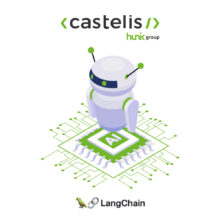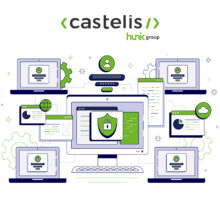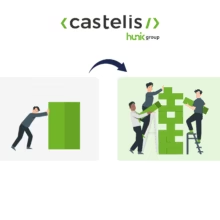
Cloudflare Zaraz Guide: Manage your third-party scripts at the Edge for better web performance
Cloudflare Zaraz is a third-party script manager designed to speed up websites, secure them, and enhance privacy. This innovative solution addresses the modern challenges of managing third-party scripts on websites. By optimizing the execution of these scripts directly at the Edge of the Cloudflare network, Zaraz offers significant benefits in terms of performance, security, and compliance.
This article dives deep into this service, comparing its strengths to Google Tag Manager (GTM) and explaining how Zaraz can transform script management on your website. Whether you’re looking to improve page loading speed, enhance data security, or simplify compliance with regulations like GDPR and the NIS2 directive, you’ll discover here why Cloudflare Zaraz could be the tool you need.
How Cloudflare Zaraz Works: Third-party tool manager to optimize third-party script loading
- Execution of third-party scripts at the Edge
Unlike traditional solutions that load third-party scripts directly into the user’s browser, Zaraz executes these scripts within Cloudflare’s infrastructure, specifically on its servers at the Edge of the network. This significantly reduces loading time perceived by the user since the browser no longer needs to download and execute these scripts. - Performance optimization
One of the major advantages of Cloudflare Zaraz is that it improves website performance by reducing the load on the user’s browser. Third-party scripts are often responsible for significant slowdowns, especially when these scripts are heavy or poorly optimized. By executing these scripts on the server side, Zaraz minimizes their impact on loading times and user experience. - Third-party script management
Cloudflare Zaraz supports the management of third-party scripts in a similar way to GTM, allowing users to manage and deploy tags without needing to directly modify their site’s code. However, since the scripts are executed at the Edge, this approach enables faster execution and less dependence on browser performance. - Security and compliance
Running scripts at the Edge also improves security. User data is processed closer to the source, which can help with compliance with data protection regulations (like GDPR in Europe) by reducing the risks associated with transmitting data to third-party servers.
Comparison with Google Tag Manager (GTM), the most popular third-party tool manager
- Execution location: GTM executes scripts in the browser, which can affect performance if many scripts are loaded or if some of them are heavy. Zaraz, on the other hand, executes these scripts on Cloudflare’s servers, reducing the load on the browser.
- Performance: Cloudflare Zaraz offers better optimization of loading times compared to GTM by moving the processing of scripts to the Edge. This results in a faster and smoother user experience.
- Complexity and configuration: GTM is widely used and has a very intuitive user interface with many out-of-the-box integrations. Zaraz, being a newer solution, is still in development and adoption, but it promises simplified management and increased performance thanks to its Edge architecture.
- Flexibility: GTM offers a lot of flexibility in terms of tag customization and event triggering. Zaraz is still developing its features, but it could become a serious contender thanks to its performance and security advantages.
In summary, Cloudflare Zaraz is positioned as an innovative solution to manage third-party scripts in a more performant way by leveraging Cloudflare’s Edge infrastructure. It optimizes website loading times by reducing the impact of third-party scripts, making it particularly attractive for performance-conscious sites. However, like any emerging technology, its adoption and evolution will be closely monitored to see how it compares to more established solutions like Google Tag Manager.
All about Cloudflare Zaraz: FAQ
1. How does Zaraz improve website performance?
Zaraz improves the performance of your website by moving the execution of third-party scripts, such as those used for analytics or advertising, from the user’s browser to Cloudflare’s servers located at the edge of the network (Edge). This means that these scripts no longer need to be loaded and executed directly on the user’s device, reducing page load times and lightening the workload on the browser.
Compared to solutions like Google Tag Manager, which execute scripts in the browser, Cloudflare Zaraz saves time by optimizing the use of user-side resources. In practice, this can result in faster page loads, a better user experience, and a reduced risk of slowdowns related to third-party scripts.
2. Is Zaraz compatible with existing third-party tools and scripts?
Cloudflare Zaraz is designed to be compatible with most of the third-party tools and scripts you already use, such as those for advertising, analytics, and user tracking. You can migrate and manage these scripts through Zaraz without losing functionality or requiring additional development. Zaraz offers a simple interface that makes it easy to integrate your existing scripts, allowing you to continue using your familiar tools while benefiting from the performance improvements it provides.
While Zaraz is compatible with many third-party tools and scripts, there are some complexities to consider. For example, some particularly complex or specific scripts that heavily rely on running in the browser or that interact directly with the DOM (Document Object Model) can pose challenges. Additionally, since Zaraz is a relatively new technology, some less common or very specialized tools may not yet be fully supported.
It is also possible that scripts may require minor adjustments to work properly with Cloudflare Zaraz, especially if they have specific dependencies that don’t translate well to the Edge. Cloudflare is actively working to expand Zaraz’s compatibility, but it is recommended to test your scripts in the Zaraz environment to ensure they function as expected.
3. How does Zaraz impact compliance with data protection regulations (such as GDPR)?
Zaraz can help with compliance with data protection regulations, such as the GDPR, by reducing the risks associated with handling sensitive data. By executing third-party scripts at the Edge, user data does not need to be directly transmitted to multiple third-party servers. This limits the exposure of personal data and gives you better control over where and how that data is processed.
Additionally, by centralizing script management within Cloudflare’s infrastructure, Zaraz makes it easier to apply data protection policies, such as anonymization or data minimization, before data is sent to third parties. This can help you meet GDPR requirements for data privacy and security.
However, it is important to properly configure Cloudflare Zaraz to ensure that all data processing practices are compliant with applicable regulations.
4. How does it impact NIS2 compliance?
Cloudflare Zaraz can also positively impact compliance with the Network and Information Systems Directive 2 (NIS2), which aims to strengthen the security of networks and information systems within the European Union.
- Reduced third-party risks: By centralizing the execution of third-party scripts on Cloudflare’s secure infrastructure, Zaraz reduces the risks associated with managing multiple direct connections to third-party services. This can help improve overall system security, a key requirement of NIS2.
- Improved resilience: NIS2 focuses on system resilience against cyberattacks. By using Cloudflare’s infrastructure to execute scripts, Zaraz benefits from the security and resilience of the Cloudflare network, including protection against DDoS attacks, which can help meet NIS2’s service continuity requirements.
- Centralized Management and Monitoring: Zaraz enables centralized management of third-party scripts, making it easier to monitor and control the activities of these scripts. This aligns with NIS2 requirements for better visibility into security risks and incidents.
- Enhanced Compliance with Security Policies: Zaraz helps enforce stricter security policies by controlling where and how third-party scripts interact with your site. This can help ensure that security practices meet NIS2 requirements, especially for heavily regulated critical industries.
5. What are the advantages of Zaraz over Google Tag Manager (GTM)?
Here is a table comparison of the pros and cons of Cloudflare Zaraz vs Google Tag Manager (GTM) to help visualize the key differences between the two:
Want to try Cloudflare too? Contact us for a free, no-obligation demo.
| Criteria | Cloudflare Zaraz | Google Tag Manager (GTM) |
| Performance | Advantage: Scripts are executed at the Edge, reducing the load on the browser and improving page load times. | Scripts are executed in the browser, which may slow down page load times if several heavy scripts are used. |
| Ease of Use | Disadvantage: Interface is still under development, with fewer resources and tutorials available compared to GTM. | Advantage: Well-established user interface, extensive documentation, and an active community for support. |
| Security | Advantage: Reduces risks from third-party scripts by centralizing execution within Cloudflare’s secure infrastructure. | Depends on browser security practices and third-party scripts, increasing potential vulnerabilities. |
| Flexibility | Disadvantage: Compatibility with certain specialized or complex scripts may be limited, sometimes requiring adjustments. | Advantage: Highly flexible with a vast library of tags and ready-made integrations, adaptable to a wide range of scenarios. |
| Third-Party Script Management | Advantage: Centralizes and optimizes scripts, simplifying data management and compliance (GDPR, NIS2). | Scripts are managed directly in the browser, which may complicate data management for regulatory compliance. |
| Integration | Disadvantage: Integrations are still under development, and some tools or scripts may not be fully compatible. | Advantage: Extensive support for a wide range of third-party services and tags, easily integrable. |
| Cost | Advantage: Included in the Cloudflare plan (depending on the tier), with potential to reduce infrastructure costs through performance optimization. | GTM is free but may incur indirect costs related to performance and managing tag complexity. |
Zaraz stands out for its enhanced performance and strengthened security by executing scripts at the Edge, making it ideal for sites that prioritize speed and data protection. However, it may require adjustments for some specialized scripts and still has a less mature interface compared to GTM.
Google Tag Manager remains a very flexible and user-friendly solution, with a large community and many ready-to-use integrations. However, it may slow down sites that rely heavily on third-party scripts, and data management can be more complex from a compliance perspective.
6. How does Zaraz affect website security?
Zaraz enhances the security of your website by executing third-party scripts at the Edge within Cloudflare’s secure infrastructure, rather than directly in the user’s browser. Here’s how this impacts your site’s security:
- Reduction of risks from malicious scripts: By executing third-party scripts on Cloudflare’s servers, Zaraz minimizes the risk of malicious or compromised scripts directly accessing the user’s browser. This reduces the attack surface for threats like code injections or cross-site scripting (XSS) attacks.
- Enhanced protection through Cloudflare: Scripts are executed within Cloudflare’s infrastructure, which benefits from multiple layers of security, including protection against DDoS attacks, web application firewalls (WAF), and other cybersecurity measures. This means that your scripts are shielded by the same security mechanisms that protect the entire Cloudflare network.
- Improved user data control and management: Cloudflare Zaraz centralizes script execution, allowing for better control over how user data is collected, processed, and transmitted. This allows you to enforce stricter security policies, such as data anonymization or limiting information sent to third-party services, contributing to better protection of personal data.
- Reduced reliance on the browser: Scripts executed in the browser can be more vulnerable to security flaws and the exploitation of browser-specific vulnerabilities. By moving script execution to the Edge, Zaraz reduces reliance on the user’s browser security, thus limiting potential attack vectors.
- Threat detection and response: Cloudflare has advanced threat detection and response capabilities. By centralizing scripts within their network, Zaraz benefits from this infrastructure, enabling quick responses in case of suspicious or malicious activities related to third-party scripts.
7. What are the limitations of Zaraz?
Although innovative, Cloudflare Zaraz has some limitations that may influence its adoption in certain contexts. Here are the main ones:
- Limited compatibility with complex scripts: Zaraz may face challenges when executing very specific or complex third-party scripts that heavily rely on direct interaction with the DOM (Document Object Model) or that require real-time rendering in the browser. These scripts may require adjustments or may not function optimally when executed at the Edge.
- Fewer integrations compared to GTM: As a relatively new technology, Zaraz does not yet have as many ready-to-use integrations as Google Tag Manager (GTM). If you use highly specialized or niche tools, you may encounter limitations in the availability of tags or plugins directly compatible with Zaraz.
- Learning curve and limited resources: Zaraz’s user interface and documentation are still under development, which can make the initial learning and implementation more complex compared to more mature solutions like GTM. Users familiar with GTM may find the transition to Zaraz less intuitive.
- Dependence on Cloudflare infrastructure: Zaraz is tightly integrated with Cloudflare’s infrastructure, meaning that to fully benefit from it, your site must already use or be migrated to Cloudflare. For organizations using other CDN providers or those not wishing to be tied to the Cloudflare ecosystem, this can represent a limitation.
- Scalability for very large enterprises: Although Zaraz is designed to handle high volumes of traffic, some very large enterprises with extremely specific or complex needs may find that Zaraz does not yet meet all their requirements, particularly in terms of fine customization or managing scripts on a massive scale.
- Potential impact on debugging: Moving script execution to the Edge can complicate debugging, as developers do not have direct access to the execution process as they would with scripts executed directly in the browser. This may require new tools or methods to diagnose and resolve issues.
8. What is the learning curve for using Zaraz?
- Ease of setup: Zaraz is designed to be relatively simple to integrate, especially if you are already using Cloudflare services. For existing Cloudflare users, adding Zaraz to a website can be done quickly through the Cloudflare dashboard. However, for those new to the Cloudflare ecosystem, there may be a moderate learning curve associated with getting familiar with Cloudflare’s interface and specific concepts.
- User-friendly interface: Zaraz’s interface is intuitive but still under development compared to more mature solutions like Google Tag Manager (GTM). Users who have experience with tag management systems will find Zaraz relatively easy to use. However, for those new to this type of tool, there may be an adaptation period to fully understand the various features and available options.
- Documentation and support: Cloudflare provides detailed documentation for Zaraz, covering most of the technical aspects needed to get started, configure, and optimize Zaraz. The documentation is a good starting point for understanding how Zaraz works and how to integrate it into your site. Additionally, Cloudflare offers support through its online community and forums, where users can ask questions and share their experiences.
- Available resources:
- Official Cloudflare Zaraz documentation: You can access the complete Zaraz documentation here: Cloudflare Zaraz Documentation.
- Cloudflare Blog: The Cloudflare blog is also a great resource for articles, updates, and use cases of Zaraz: Cloudflare Blog.
- Community support: Cloudflare offers a forum where users can exchange tips and solutions: Cloudflare Community.
9. Does Zaraz work with non-Cloudflare CDN solutions?
Zaraz does not work with non-Cloudflare CDN solutions. To use it, your site must be configured to use the Cloudflare network. This change can offer advantages in terms of performance and security, but it requires an evaluation of the trade-offs related to leaving your current CDN.
Associated Trade-offs:
- Dependence on Cloudflare: One of the main trade-offs is that you will need to migrate to Cloudflare to benefit from Zaraz. This can be a hurdle for companies already invested in other CDN solutions, especially if those solutions offer specific features or integrations they rely on.
- Transition to Cloudflare: If you decide to switch to Cloudflare to use Zaraz, this may require transitioning your current CDN infrastructure to Cloudflare’s. This migration could include technical, contractual, and performance considerations depending on the complexity of your existing infrastructure.
- Performance and features: By switching to Cloudflare, you could benefit from some of their network’s advanced features, such as DDoS protection, an integrated WAF, and other performance tools. However, you will need to evaluate whether these benefits outweigh the specific features your current CDN may offer.
10. What are the costs associated with using Zaraz?
Zaraz is included in Cloudflare plans, which means that if you are already a Cloudflare customer, you can access Zaraz at no additional cost, depending on your plan level. It is available to both free plan users and paid plan users, although some advanced features may be reserved for higher-tier plans (Pro, Business, or Enterprise).
Potential Additional Costs
- Cost planning: For most users, using Cloudflare Zaraz does not generate direct additional costs beyond what is already paid for the Cloudflare plan. However, users on free or lower-tier plans who want to access more advanced features of Zaraz may consider upgrading to a higher plan, which could incur extra costs.
- Technical resources: If integrating Zaraz requires adjustments or custom development, there could be indirect costs related to hiring developers or using internal technical resources to adapt and configure Zaraz according to the site’s specific needs.
Return on Investment (ROI)
- Performance improvements: Cloudflare Zaraz optimizes page load times by executing third-party scripts at the Edge, which can boost conversion rates and reduce bounce rates, thereby improving the user experience.
- Reduction in infrastructure costs: By reducing the load on origin servers, Zaraz can lower bandwidth costs and decrease the need to invest in additional performance solutions, resulting in savings on infrastructure.
- Enhanced security and compliance: Zaraz improves user data management and reduces risks associated with third-party scripts, helping to avoid potential costs related to data breaches and non-compliance with regulations, which is an indirect but crucial financial benefit.
11. What support is available for Cloudflare Zaraz?
Zaraz benefits from strong support, including detailed documentation, an active community, and technical assistance tailored to your Cloudflare plan level. Additionally, certified partners like Castelis are available to provide specialized assistance, which is particularly useful for companies adopting Cloudflare Zaraz in complex environments or seeking personalized support.
- Official Documentation
Cloudflare offers comprehensive documentation for Zaraz, covering all aspects of installing, configuring, and using the tool. This documentation is regularly updated and is accessible online, allowing users to find detailed information about Zaraz features and troubleshoot most common issues on their own. You can view this documentation here: Cloudflare Zaraz Documentation. - Community Support
Cloudflare has an active community where users can ask questions, share experiences, and find solutions to technical issues. The community forums are a great resource for getting practical advice from other Zaraz users and staying up to date with the latest updates and tips. Access the Cloudflare Community here: Cloudflare Community. - Cloudflare Technical Support
Cloudflare customers can access direct technical support, which varies in level depending on the plan they purchase (Free, Pro, Business, or Enterprise). Business and Enterprise plans offer priority support with faster response times and access to technical experts. Users of these plans can submit tickets for specific issues or contact support for more personalized assistance. - Cloudflare Partners, such as Castelis
For businesses that need more in-depth support or consulting services to integrate and optimize Zaraz, Cloudflare Certified Partners, such as Castelis, are available. These partners can provide tailored assistance, from initial setup to ongoing management and performance optimization. They can also help integrate Zaraz into complex environments or migrate other solutions to Cloudflare.
Cloudflare Zaraz, the future of third-party script optimization
Cloudflare Zaraz presents itself as an innovative solution for third-party script management, offering significant benefits in terms of performance, security, and compliance. Although it’s a relatively new technology, its integration with Cloudflare’s Edge Network sets it apart from existing solutions like Google Tag Manager.
However, like any emerging technology, Zaraz has some limitations, particularly in terms of compatibility and available resources. Interested businesses should carefully assess their specific needs and consider adopting Cloudflare Zaraz to maximize the benefits of this new approach to third-party script management. For those looking for additional support, Cloudflare offers a range of resources and certified partners to ensure a smooth transition and ongoing optimization.
Examples and customer cases for managing third-party scripts with Cloudflare Zaraz
Zaraz is a new solution, but Cloudflare has shared some general uses and benefits of Zaraz, as well as examples of customers who have started to adopt it.
- Ad Script Optimization for a Content Publisher:
- Background : An online content publisher that uses many ad scripts to monetize its traffic found that these scripts were significantly slowing down page load times, impacting user experience and ad revenue.
- Solution with Zaraz : By migrating these scripts to Cloudflare Zaraz, the publisher was able to run the scripts at the Edge level, reducing the load on the user’s browser. Result: faster page load times and an increase in ad conversion rates, which helped maximize revenue.
- Impact : Significant improvement in load times, increased user retention rates, and increased ad revenue.
- Performance Improvement for an E-commerce Site:
- Background : An e-commerce site was experiencing slowdowns due to the use of many third-party scripts for user tracking, analytics, and marketing tools. These slowdowns were impacting sales and user experience.
- Solution with Zaraz : By using Cloudflare Zaraz to manage and execute these scripts at the edge, the site was able to significantly improve load times while maintaining critical tracking and marketing functionality.
- Impact : Reduced bounce rates, improved conversion rates, and a smoother user experience.
- Compliance and Security for a Financial Services Company:
- Background : A financial services company needed to strictly comply with data protection regulations, such as GDPR, and was concerned about the risks associated with third-party scripts, particularly in terms of data security.
- Solution with Zaraz : By centralizing the execution of third-party scripts in Cloudflare’s secure infrastructure via Zaraz, the company was able to reduce the risk of data leaks and strengthen its regulatory compliance without compromising site performance.
- Impact : Better management of third-party script risks, increased GDPR compliance, and maintained site performance.
Next Steps to Adopting Cloudflare Zaraz
- Try Cloudflare Zaraz for Free: If you’re already a Cloudflare user, enable Zaraz directly from your dashboard and start experimenting with your third-party scripts. For new users, sign up for a free Cloudflare account and learn how Zaraz can optimize your site’s performance.
- Check Out the Documentation: Get familiar with all of Zaraz’s features and configurations by browsing the official Cloudflare Zaraz documentation. This detailed resource will guide you through each step to get the most out of this solution.
- Join the Cloudflare Community: Engage with other Zaraz users in the Cloudflare Community. Ask questions, share experiences, and stay up-to-date on best practices and the latest updates.
- Contact a Cloudflare Partner: For custom integrations or in-depth technical support, consider working with a certified partner like Castelis. These experts can help you maximize the benefits of Cloudflare Zaraz, especially in complex environments or for large-scale enterprises.
- Monitor Results and Optimize: Once Zaraz is in place, use Cloudflare’s performance monitoring tools to track the impact of third-party script optimization on your site. Identify opportunities for continuous improvement to ensure an optimal user experience.
Want to try Cloudflare Zaraz too? Contact us for a free, no-obligation demo.
Voir plus de Actualités

Cloudflare Zaraz Guide: Manage your third-party scripts at the Edge for better web performance

Optimizing the use of LLMs in business thanks to RAG (Generation Augmented by Recovery)

Everything you need to know about the NIS2 Directive: requirements, sanctions and compliance solutions
